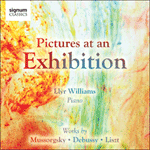
Welcome to Hyperion Records, a British classical label devoted to presenting high-quality recordings of music of all styles and from all periods from the twelfth century to the twenty-first.
Hyperion offers both CDs, and downloads in a number of formats. The site is also available in several languages.
Please use the dropdown buttons to set your preferred options, or use the checkbox to accept the defaults.

| Llŷr Williams (piano)» More |
from notes by Leslie Howard © 1990
 Liszt: Complete Piano Music Liszt: Complete Piano MusicLeslie Howard’s recordings of Liszt’s complete piano music, on 99 CDs, is one of the monumental achievements in the history of recorded music. Remarkable as much for its musicological research and scholarly rigour as for Howard’s Herculean piano p ...» More |
 Musorgsky: Pictures from an exhibition; Debussy: Estampes; Liszt: Ave Maria Musorgsky: Pictures from an exhibition; Debussy: Estampes; Liszt: Ave MariaDescribed as 'one of the truly great musicians of our time' by The Times, Llyr Williams brings an extraordinary musical intelligence to his interpretations. These works are all evocative musical 'pictures' of different times and places: from Debus ...» More |

